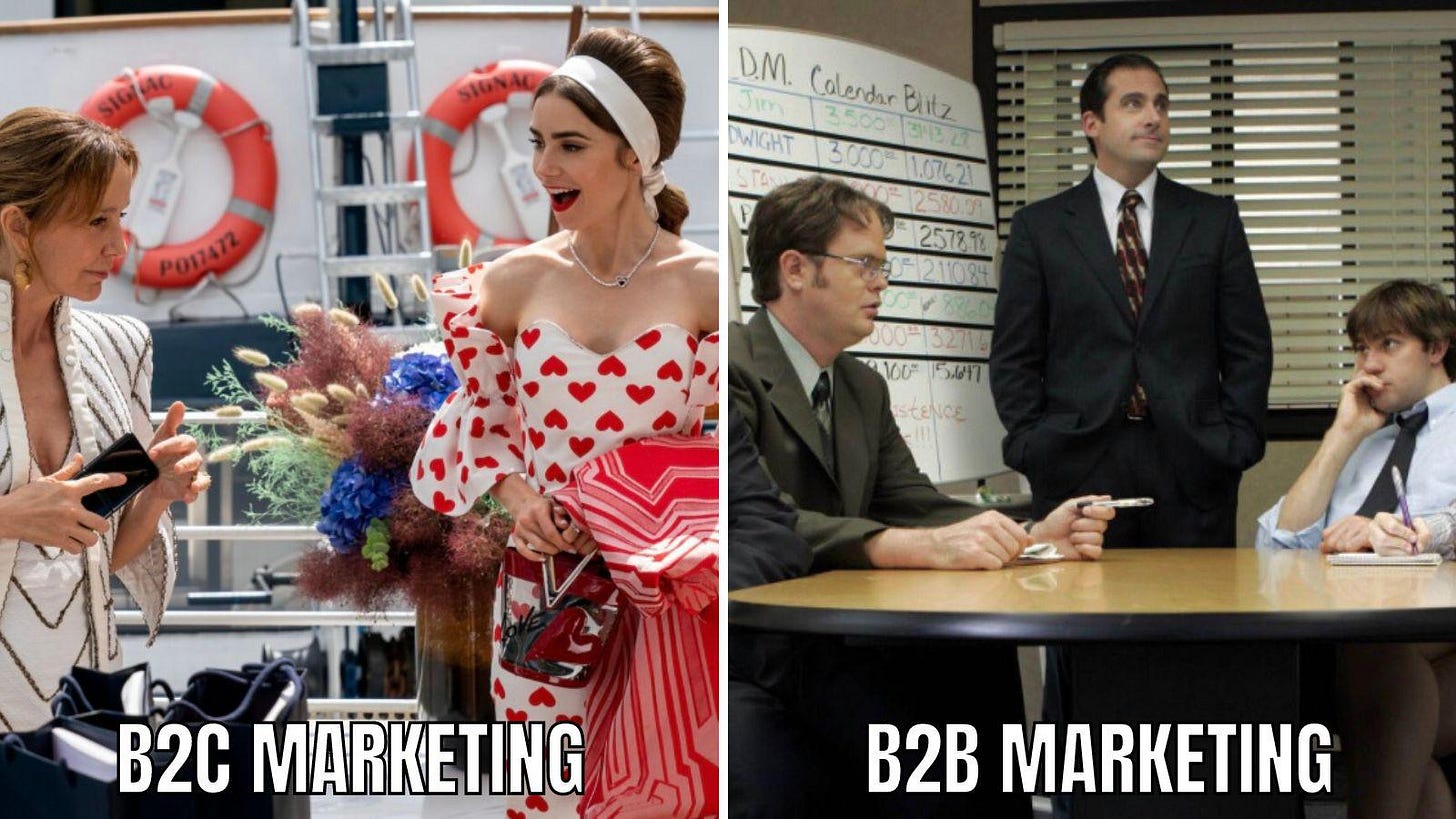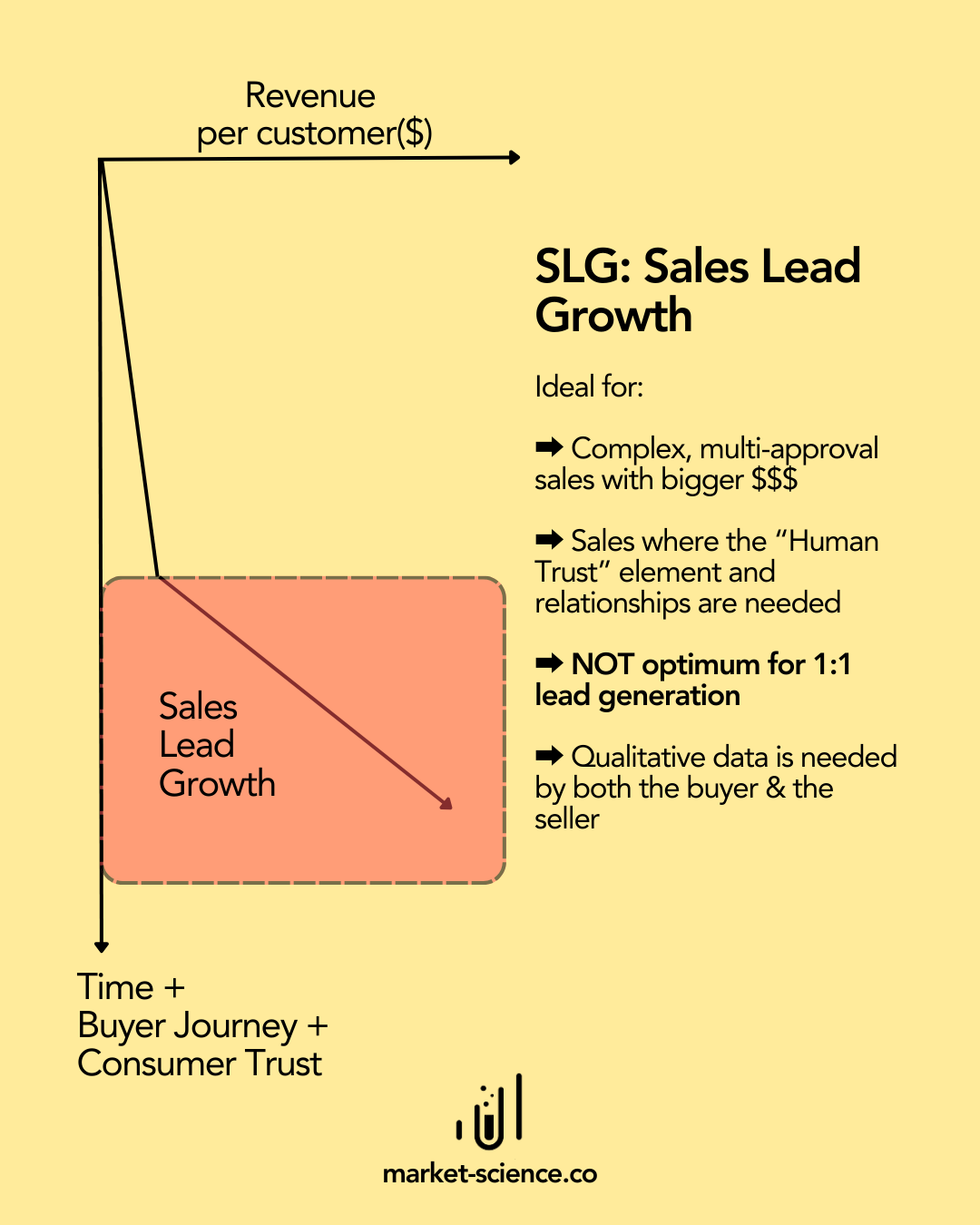Is B2B marketing turning into B2C?
Rise of the digital generation, flooded markets, flatter company structures and more...
Many years ago B2B purchasing decisions were pretty much driven from the top down.
It paid to know the executives - because executives choose the vendors.
Options were low and software was complex - so human intervention was essential to find the right person and pitch the right value.
Having a strong sales team was the aim of the game. Relationships were everything.
Getting sales teams to have beers with executives was likely going to end in a P.O. at some point.
B2B marketing was more of a supporting function - focused on logos, taglines, expo booths, websites and pitch decks.
And whilst it certainly still pays to have connections at the top, 30 years of the internet and a rapidly growing society (both in size and complexity) has changed the buying landscape.
But what’s changed?
Well firstly, let’s clarify:
B2B = Business to Business = A type of transaction that takes place between one business and another. (E.g. Products like Xero, Airtable, DocuSign, etc.).
I.e. smaller focused markets + complex decision making.
B2C = Business to Consumer = A type of transaction that takes place between a business and a consumer. (E.g. Products like Netflix, Airbnb, Amazon, etc.).
I.e. Larger generalised markets + simpler decision making.
B2C markets require predominately marketing-led engagement focusing on casting a wider transactional-focused net to encourage:
Faster, emotion-driven decisions: Appealing to consumers' emotional triggers, personal desires, and lifestyle choices. A strong emphasis on vendor brand.
Customer experience & simplicity: Emphasizes on creating a seamless, user-friendly customer experience from start to finish (encourage quick decision-making).
Visual & entertaining content: Things like videos, social posts, and influencer collaborations. Storytelling and memorable advertising campaigns to create a ‘buzz’ and influence immediate action.
Is B2B marketing beginning to look like this?
In some cases, yes. But why?
Well, a couple of reasons:
The number of B2B vendors is growing at an alarming rate - there is an abundance of options. There’s an app for everything and everyone (and most are getting good!). It’s no longer feasible to bottleneck B2B buying decisions to executives. So companies are getting flatter and end users now have more say.
A rising population in the era of digital creators and social media means we are now flooded with content. The B2B world is made almost entirely of e-books. Buyer attentions are at capacity. We now only have seconds to capture it. We need to appeal to the more instinctive emotions triggers to win attention.
The digital-native generation is rising the ranks. Millennial CEOs and Execs are now emerging. With the advancement of UI/UX and the now digitally capable B2B buyers, people are preferring self-service options. The rise of Product-led Growth is no longer a trend. It’s now an expectation.
B2B buyers are now pushing back on engaging sales until the last minute. There is an abundance of information to influence buyer choice. People are shortlisting and narrowing their choice until complex decisions and questions are required.
In a nutshell:
we are being forced to influence B2B buyers indirectly, at scale and in shorter transactional moments… Much like… B2C Marketing…
Reason 1: Companies are now flatter. We must influence the users.
The average number of SaaS applications per company has increased from 110 in 2023 to 130. With a 5x increase over a period of 3 years and a total of 10x since 2015 (Bettercloud).
Each department and each role has dozens of applications they use regularly (with more popping up each year).
Back when there were only a handful of highly complex and highly expensive B2B products that spanned multiple departments - it made sense for leaders to drive the decisions.
But as the amount of applications has increased, the specialisation and sub-categories for each has expanded.
The cost and barriers to adopt have shrunk - decision-making authority has become more distributed among teams.
I.e. End-users of products now play a much bigger role in selecting software or services (since they know what they need).
We now need to speak directly to the people who will actually use the product.
We need to connect and influence B2B user-buyers through things like videos, social posts, influencers, storytelling and memorable advertising campaigns
The user’s voice is louder in buying decisions. In flatter organizations this mean users now do their own research before championing it internally.
Reason 2: We now have seconds to capture attention.
Next to oil and data - ‘attention’ is now the most valuable commodity.
B2C marketing has long mastered the art of short, sharp emotional appeal - leveraging storytelling, relatable pain-points, and lifestyle aspirations.
More importantly - they’ve been able to do it in bite sized pieces (clever images, short clips, billboards, etc.)
The human brain processes images around 60,000 times faster than text. It takes only 13 milliseconds for the brain to process an image’s message (The Power of Visuals).
Leading B2C channels like TikTok and Instagram have known this for years.
Love it or hate it - short-form content is now becoming a norm for consuming information.
B2B buyers in the initial stages now expect the same (more on that here).
Whilst attention is only the first stage of many steps in the B2B process - it’s arguably the most important - since the rest of the buyer journey is impossible without it.
B2B buyers, after all, are human, and they are now bombarded with more content than ever before.
To cut through this noise, marketers must now create messaging that resonates quickly and emotionally, not just rationally.
Similar to B2C marketing - this could mean using humour or entertaining content to highlight the day-to-day frustrations that your product solves.
Or tapping into broader aspirations, like a sense of purpose within their roles.
Reason 3: The digital-native generation is rising the ranks
Millennials and Gen Z, raised in the digital age, are moving into leadership positions.
The demographic that grew up with seamless, user-friendly products like Netflix and Amazon now expect the same from B2B solutions.
They are more inclined toward self-service, product-led, intuitive digital tools.
Not to mention their repulsion to picking up the phone and calling someone…
Interacting with the world through digital mediums has come at opportunity cost for both sides.
Generally speaking - buyers don’t like talking to vendors unless they want to or have to…
This shift is pushing B2B companies to reimagine their customer journeys to be more like B2C: easy, fast, and requiring minimal human intervention.
At least at the first stages:
The digital-native buyer expects personalized experiences, intuitive user interfaces, and immediate gratification - making traditional, high-touch B2B marketing feel outdated and exhausting.
This may come across as eye-rollingly annoying to some vendors - but it’s a market trend that could be costly to ignore.
Reason 4: Buyers are pushing back on sales until the last minute!
More buyers are waiting to the very last minute to speak with sales teams (or resisting them altogether).
Research by G2 in 2023 found that 68% of buyers only involve sales at the last stage of the buyer's journey.
Whilst the role of sales is still incredibly important for B2B growth, we need to find better, indirect ways to engage and sell - long before they’re willing to speak to us.
This pushback on sales in the early stages means marketing must do more of the heavy lifting to educate, nurture, and build trust with potential buyers.
By the time a buyer finally reach out to a sales team, they most likely already have a short list and a solid understanding of what they want.
Which on the bright side should mean better conversations with educated buyers.
This is why it's crucial to invest in content that educates (and provides value) early on.
Content marketing, community building, webinars, case studies, and transparent pricing models all play key roles in capturing buyer trust long before sales ever get involved.
Note: B2C behaviour is evolving - but sales is still critically needed!
Better product marketing and PLG are becoming important - but it’s critical to remember that complex decisions still require sales intervention.
Even with the state of Ai in 2024 - we are still far from the point to go ‘hands free’ B2B sales.
When each buyer has a unique set of challenges and requires a uniquely configured solution which has to go through a complex buying process with multiple stake holders - human intervention is not just better - it’s essential.
The average enterprise B2B buying group consists of five to 11 stakeholders, who represent an average of five distinct business functions. Meeting needs and driving consensus can be a challenge. (Gartner)
Whilst new age buyers are preferring self-service B2B options - there is still a point where human guidance is simply irreplaceable.
It just means when they get to this point, they’re ready, they want answers and qualified advice to fix their problems.
Until that point, we need to meet buyers where they are at and provide:
Better, more thought provoking content that is
filled with engaging, entertaining, short-form experiences that will
Win their attention in noise landscape which leads them to
Seamless, user-friendly customer experience from start to finish for a chance at
Building enough trust and intrigue that they want to look at purchasing your product.
Or it could all just be fad…
Please ❤️like this post if you enjoyed reading :)








